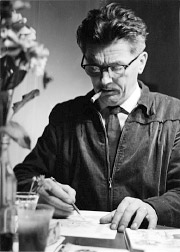In 1910, three-year-old Werner and his parents moved from their hometown of Chemnitz in Saxony to St. Gallen. Weiskönig showed a talent for drawing from a young age, inheriting his aptitude from his father, a lithographer by trade. He left school early to attend classes on the emerging profession of graphic design at the art school in St. Gallen. It was there, at the age of eighteen, that he was tasked with designing stamps. His work was featured in a wide range of student exhibitions, where it even caught the attention of the Swiss postal service, which invited the young man to participate in competitions. From 1930 to 1931, he studied at the Kunstakademie Düsseldorf (Arts Academy) before returning to St. Gallen to work as a freelance artist. In 1938, he designed one of the first series of postage due stamps, and would later go on to win a considerably more creatively challenging competition to design a ‘Swiss towns’ series. Weiskönig soon became one of Switzerland’s most successful stamp designers, beating other illustrious artists to win top prizes for every one of his 36 series. He also made a name for himself designing striking posters, such as his highly stylised work for the municipality of Davos in 1930, and his bold design for the 1954 football World Cup. His life’s work has been preserved by his daughter, Helga Lutz, meaning that the Swiss Graphic Design Foundation can finally give the artwork of this important yet relatively unknown designer the recognition it deserves.


